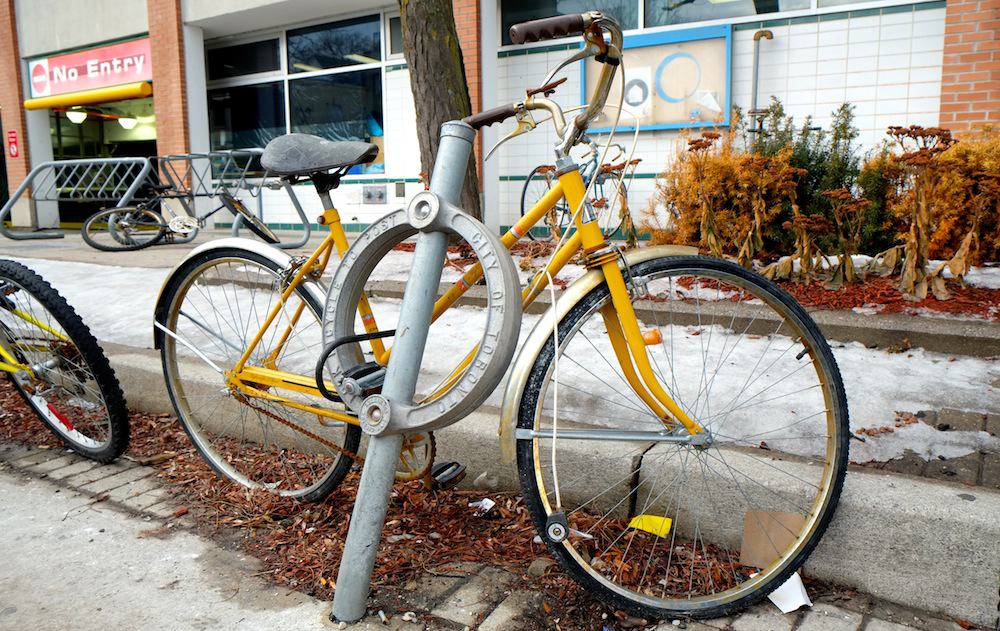When the temperature plummets below zero, and snow and ice start to cover up the city streets, many cyclists hang up their helmets and park their U-locks for another winter of commuting by TTC.
A few resilient souls, however, brave the frost and peddle on through the winter months. While these bikers might seem courageous (or, alternatively, crazy), winter cycling is not as unsafe as it may seem. By taking extra precautions and planning ahead, your winter commute on two wheels can run just as smoothly as your summer cycle — with slightly chillier fingertips, of course.
There are three main things that need to be considered before hitting the slushy roads – the bike, the rider, and the route. With necessary alterations and modifications, you can successfully navigate winter road conditions on your bike.
1. Take extra care of your bike
Just like a car, a bike needs to be tuned up every now and again in order to be protected from the inevitable wear and tear of use. There are a few measures you can take in order to steel your bike for the winter season:
— Consider purchasing a cheaper bike if you have a steel frame to avoid the metal rusting in the snow. Alternatively, bandage up your bike frame to avoid damage, making sure that any exposed pieces of metal are painted over to avoid slush and snow.
— Occasionally spray the seat post and any holes with a rust-resistant lube to prevent rusting.
— Deflate your tires slightly in order to increase your grip on the road.
— Attach fenders to your bike to keep the inevitable mess from the slush to a minimum and protect your butt.
2. Layer up
Make sure every piece of your skin is covered, because frostbite can set in rapidly on cold days. You want to dress so that you are a little cold when you start off your ride, because you will get hot as you go and warm up to a comfortable temperature:
— Start with wicking fabric close to your skin to wick away the sweat.
— Layer insulating fabrics on top of that to keep your body heat in and then add a wind-proof layer.
— Make sure every inch of your skin is covered. Scarf, balaclava, ear muffs that attach to your helmet, goggles to keep the wind out of your eyes, and gloves to protect your precious digits are all accessories that are worth investing in.
3. Check the weather
When asked why he still chooses to ride his bike in the winter, winter cyclist Nathan noted, “I love it as a mode of transportation. Traffic is never an issue. It’s faster than anything else — I can make it from one side of town to another in 15 minutes.”
Before trying to beat the traffic on your bike, take a look at the weather conditions and notice the temperature, wind chill, ice conditions, and street conditions:
— Consider setting a temperature limit for your winter cycling threshold, and take the TTC if the weather is past that point.
— There is a trade-off in choosing which roads to ride on — busier roads that have more car traffic will have less snow, but in turn, increased car traffic render them potentially more dangerous.
4. Plan your route
There are more obstacles on the road in the winter that you have to avoid, so plan your route in advance so you can anticipate these issues. Snow banks will be blocking lanes, potholes will be filled with slush, and black ice will laden the road. Channel your inner-gamer and avoid these at all costs — there just might be some coins for you to collect at your destination. Maybe.
5. Don’t get fancy
Cycling with caution is a rule of thumb across all seasons. Especially in slippery winter conditions, cocky maneuvers and overconfidence can land you in the trajectory of a snow bank or a moving vehicle. Leave more time to brake, and, when braking, do so mostly with the rear brake so you still have steering available with your front end.
6. Use common sense
In the end, it comes down to common sense. Know when it’s safe to ride and when it isn’t, and play it safe when you’re out there. If you prepare properly and keep a level head, cycling can be an ideal mode of transportation any time of the year.
Winter cyclist Rodolfo adds on a chilly day in Kensington Market, “There is no better way to get around than on your bike.”


